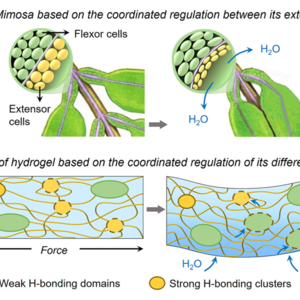Hydrogels with Differentiated Hydrogen-Bonding Networks for Bioinspired Stress Response
Citation
Wei Zhao, Zhouyue Lei*, Baohu Wu, and Peiyi Wu*. Hydrogels with Differentiated Hydrogen-Bonding Networks for Bioinspired Stress Response. Angew. Chem. Int. Ed. 2024, 63, e202400531.
Abatract
Stress response, an intricate and autonomously coordinated reaction in living organisms, holds a reversible, multi-path, and multi-state nature. However, existing stimuli-responsive materials often exhibit single-step and monotonous reactions due to the limited integration of structural components. Inspired by the cooperative interplay of extensor and flexor cells within Mimosa’s pulvini, we present a hydrogel with differentiated hydrogen-bonding (H-bonding) networks designed to enable the biological stress response. Weak H-bonding domains resemble flexor cells, confined within a hydrophobic network stabilized by strong H-bonding clusters (acting like extensor cells). Under external force, strong H-bonding clusters are disrupted, facilitating water diffusion from the bottom layer and enabling transient expansion pressure gradient along the thickness direction. Subsequently, water diffuses upward, gradually equalizing the pressure, while weak H-bonding domains undergo cooperative elastic deformation. Consequently, the hydrogel autonomously undergoes a sequence of reversible and pluralistic motion responses, similar to Mimosa’s touch-triggered stress response. Intriguingly, it exhibits stress-dependent color shifts under polarized light, highlighting its potential for applications in time-sensitive "double-lock" information encryption systems. This work achieves the coordinated stress response inspired by natural tissues using a simple hydrogel, paving the way for substantial advancements in the development of intelligent soft robots.


